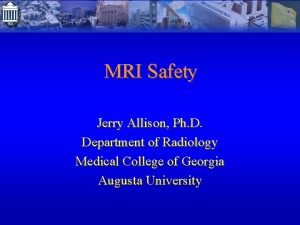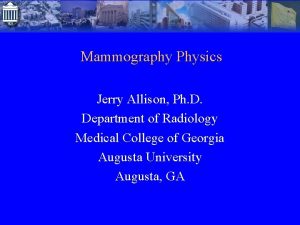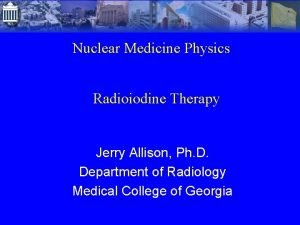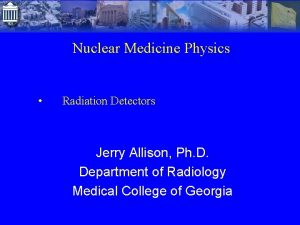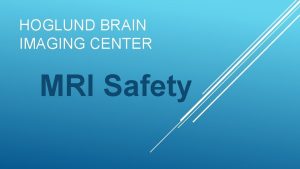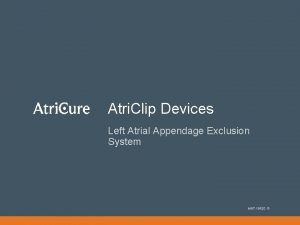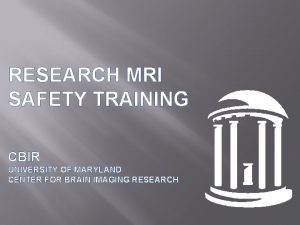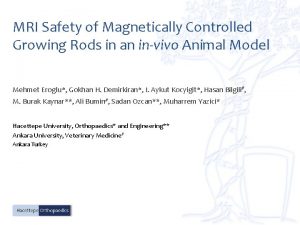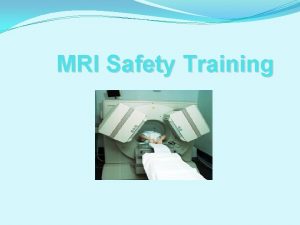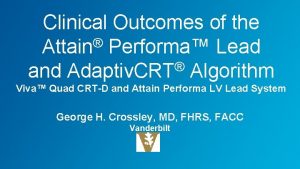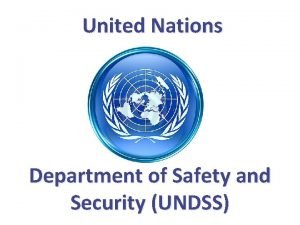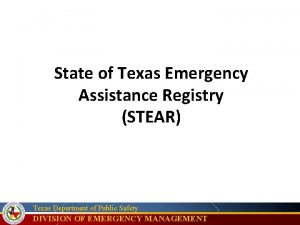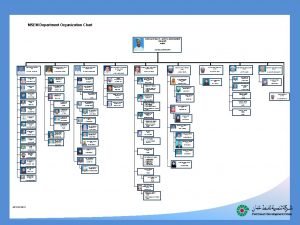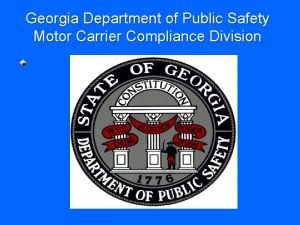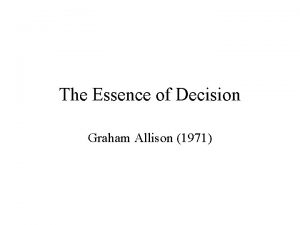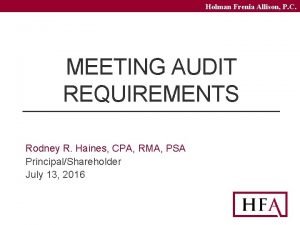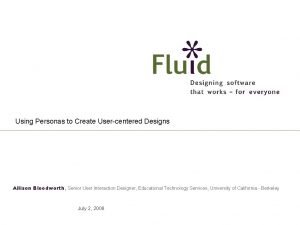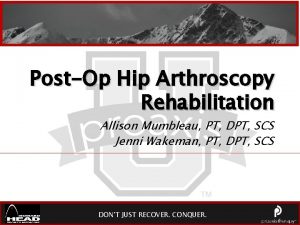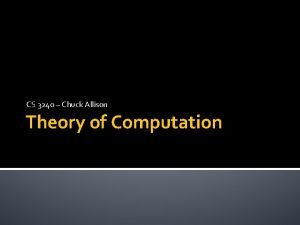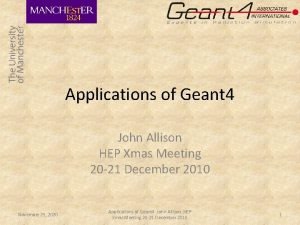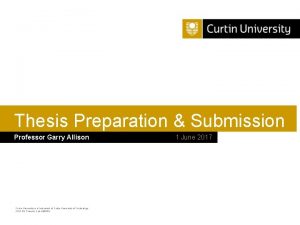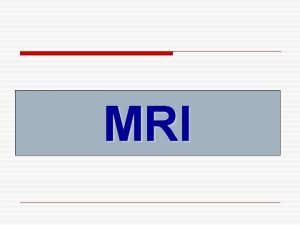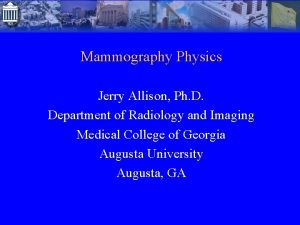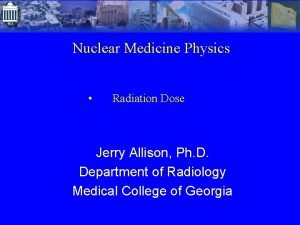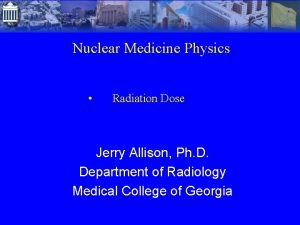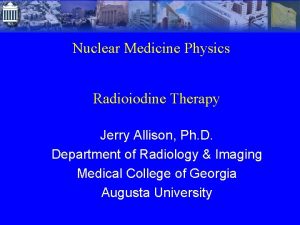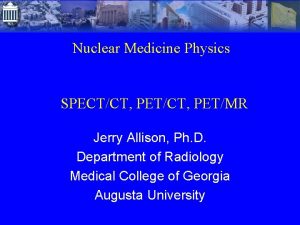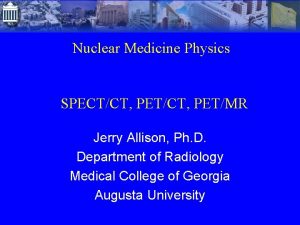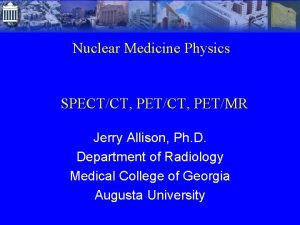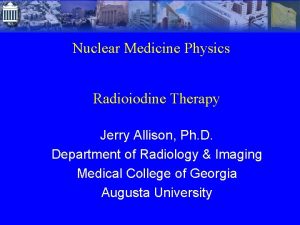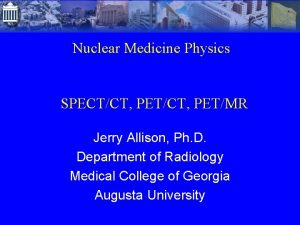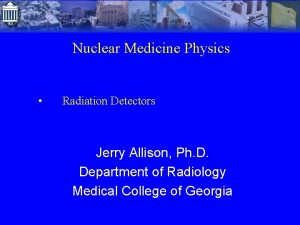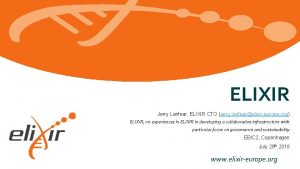MRI Safety Jerry Allison Ph D Department of


















































- Slides: 50

MRI Safety Jerry Allison, Ph. D. Department of Radiology Medical College of Georgia Augusta University

MRI Safety Projectile Accidents Foreign Materials in the Body Other Stuff

Projectile Accidents • The MRI magnets are ALWAYS on (24 hours/day, 365 days/year) • There is a STRONG fringe magnetic field around the magnets • The fringe magnetic field is confined to the scan room 3

Projectile Accidents • The fringe magnetic field can cause ferrous metal objects to fly into the bore of the magnet with great force and speed • Ferrous metal objects contain iron (steel) • The closer you are to the bore of the magnet, the stronger the fringe field 4

As you approach the magnet, the fringe magnetic field gets STRONGER 5

http: //simplyphysics. com/flying_objects. html# 6

Projectile Accidents • • • The fringe magnetic field can be deadly Valhalla, N. Y. Westchester County Medical Center July 27, 2001 Six year old Michael Colombini was fatally injured “when an oxygen canister was turned into a guided missile by the powerful MRI magnet” 7

Foreign Materials in the Body • Foreign material in the body is a concern in MRI • Foreign material is any material in the body other than the flesh and bones that we are born with • Wide variety of foreign material is intentionally and unintentionally present in patients, health care providers and others 8

Foreign Materials in the Body • The presence of certain foreign materials in the body can be fatal in an MRI magnet • Deaths have occurred due to the presence of aneurysm clips and cardiac pacemakers in patients undergoing MRI • Sight has been lost by movement of ferrous metal in the eye resulting in vitreous hemorrhage (2. 0 mm x 3. 5 mm iron fragment @ 0. 35 T) • Prostheses are usually securely anchored to bone and are usually non-ferrous. 9

Foreign Materials in the Body • Fringe magnetic fields stronger than 5 Gauss can affect cardiac pacemakers. • To protect patients and others having pacemakers there is a 5 Gauss Exclusion Zone around MRI magnets. • At AU Health, the Exclusion Zones are the MRI scan rooms 10

Fringe Diagram of Active Shield 1. 5 T* 5 Gauss 26’ 4” 16’ 6” *Siemens Symphony 11

Safety (continued) -At least two deaths have resulted from MRI Scans on patients with pacemakers. 12

Foreign Materials in the Body • Heating of metals and implants has not been significant (even for large prostheses) • There are resources for assessing safety of foreign materials in MRI • www. mrisafety. com • F. G. Shellock. Reference manual for Magnetic Resonance Safety: 2017 Edition (© 2017 730 pages; ISBN 978 -0 -9891632 -4 -8) 13

Aneurysm Clips www. mrisafety. com 14

Signage • FDA Guidance for the Submission Of Premarket Notifications for Magnetic Resonance Diagnostic Devices states: • "The controlled access area should be labeled "Danger High Magnetic Field" at all entries. " • The term "warning" does not convey the importance of a situation that may not only be potentially hazardous, but has been responsible for serious injuries and deaths. 15

16

M R I Physics Course Other Safety Issues Static Magnetic Fields Time Varying Magnetic Fields RF Magnetic Fields Auditory Safety FDA Safety Guidelines Contrast Agents 17

M R I Physics Course Other Safety Issues Psychological Distress Cryogen Safety Experiences at Higher Magnetic Fields Pregnancy 18

Safety (continued) Biological effects of static magnetic fields -Augmentation of the T wave during peak flow in the aortic arch -No evidence of mutagenic effects (in vitro or in vivo) -No evidence of an effect on organ development in vivo -No pronounced threshold -No trends suggestive of a dose response curve 19

Safety (continued) Biological effects of static magnetic fields “In general, there is no conclusive evidence for irreversible or significant biological effects related to acute, short-term exposure of humans to static magnetic field strengths up to 2. 0 T. ” MRI systems up to 8 T are in use for human imaging. 20

Safety (continued) Biological effects of RF magnetic fields -RF magnetic fields are oscillating magnetic fields -These fields produce heating of tissue -Energy deposited (degree of heating) is measured by the Specific Absorption Rate (SAR) in units of Watts/kilogram 21

Safety (continued) Biological effects of RF magnetic fields - SAR depends upon flip angle, TR, tissue density, RF pulse duration and frequency, RF coil radius, tissue conductivity and static magnetic field. -Guidelines restrict rise in core temperature to <1 o. C 22

Safety (continued) Biological effects of RF magnetic fields -Similar to ultrasound since as long as the energy deposited is below established limits, minimal heating of tissues occurs. -Extra precautions are necessary for patients with compromised thermoregulation: fever, diabetes, obesity, cardiovascular disease, old age, medicated ( and Ca channel blockers), anesthesia 23

Safety (continued) Biological effects of RF magnetic fields -Thermal burns -Electrical conductors can absorb energy and become extremely hot -Avoid having any cable wire or lead in contact with the patient -Surface coil cables can be placed in sleeves to prevent burns 24

Safety (continued) -FDA Safety Guidance for MR Devices http: //www. fda. gov/cdrh/ode/guidance/793. html 25

Safety (continued) Biological effects of time varying (gradient) magnetic fields -Faraday’s Law: Induction of electric fields and currents in tissues (depends on tissue conductivity, gradient strength, risetime, waveshape, polarity, repetition time TR and duration of the scan) -Eddy current formation 26

Safety (continued) Biological effects of time varying (gradient) magnetic fields -Nerve stimulation: electrical stimulation of peripheral and cutaneous nerves should precede any stimulation of ventricular fibrillation. Guidelines for time varying magnetic fields are designed to prevent any perceptible nerve stimulation ( with a safety factor of times three) -Magnetophosphenes: perceptible light flashes caused by electrical stimulation of the retina (not experienced in imagers having field strengths less than 4. 0 T) 27

Safety (continued) Biological effects of time varying (gradient) magnetic fields “…guidelines are believed to provide a wide margin of safety with respect to exposure to gradient magnetic fields during MRI…newer “fast scanning” techniques that may require more complex applications of gradient magnetic fields may easily exceed these recommended levels and must be thoroughly evaluated for potential health hazards. ” -Time varying magnetic fields are used to stimulate bone healing 28

Stimulation Threshold Levels Mean Cardiac Stimulation Threshold 3600 T/s = Tesla per second Mean Respiratory Stimulation Threshold Mean Painful Nerve 900 T/s Stimulation Threshold 90 T/s 0 - 20 T/s = clinical mode Controlled Modes* Mean Peripheral Nerve Stimulation Threshold >20 T/s = First or Second * Limited by IRB or Human Ethical Committee 60 T/s 45 T/s Typical Operating Range 20 T/s MR Safety Guide © 2003 by General Electric Company, Inc. 29

Due to the rapid rate of change of the magnetic fields (d. B/dt) used during some EPI scans, a percentage of patients may experience a tingling or touch sensation. This means a percentage of patients may experience Peripheral Nerve Stimulation (PNS) at 45 T/s. If this sensation is bothersome or uncomfortable to the patient, stop the scan. Change to a non-EPI pulse sequence to continue scanning the patient. MR Safety Guide © 2003 by General Electric Company, Inc. 30

Safety (continued) • Auditory safety • Activation of gradient magnetic fields produces significant vibrations in the gradient coils. • MRI acoustical noise has been shown to produce reversible hearing impairment and could potentially produce permanent damage. • Hearing protection is recommended for all patients undergoing an MRI procedure on a high-field MRI system (1. 5 T and 3. 0 T). • Noise attenuating ear-plugs or head phones are routinely used in MRI 31

Safety (continued) -FDA Safety Guidance for MR Devices http: //www. fda. gov/cdrh/ode/guidance/793. html 32

Safety (continued) -MRI manufacturers often use SAR level control (based on IEC guidance? ): Normal mode (or clinical mode): admissible for all patients First level: increased SAR permissible under “medical supervision” Second level: use of higher levels of SAR under IRB approval (research) 33

Safety (continued) -GE SAR levels 34

Safety (continued) -GE d. B/dt levels 35

Safety (continued) -Contrast agents -Gd-DTPA is significantly safer than iodine based contrast agents used in X-ray procedures (x 10) -Severe reactions do occur -Pregnancy: Gd-DTPA may have poor clearance from amniotic fluid -Gadolinium may cause Nephrogenic Systemic Fibrosis (NSF) 36

Safety (continued) -Contrast agents FDA Requests Boxed Warning for Contrast Agents Used to Improve MRI … patients with severe kidney insufficiency who receive gadolinium-based agents are at risk for developing a debilitating, and a potentially fatal disease known as nephrogenic systemic fibrosis (NSF). In addition, it would state that patients just before or just after liver transplantation, or those with chronic liver disease, are also at risk for developing NSF if they are experiencing kidney insufficiency of any severity. 37

Safety (continued) -Psychological Distress (before, during and after MRI) Claustrophobia Anxiety Depression Panic Disorders -RF coils need to be near the body for high signal to noise -Usually transient (2 cases of claustrophobia persisted requiring psychiatric treatment) 38

Safety (continued) -Psychological Distress -Countermeasures Briefing Friend or relative in scan room Physical or verbal contact with patient Prone Mirrors, prism glasses, video goggles Blindfold Relaxation strategies Psychological desensitization techniques 39

Cryogen Safety • Superconducting MRI magnets use cryogens (1970 liters of liquid helium) • Magnets can QUENCH resulting in conversion of the liquid helium to gaseous helium • 1970 liters of liquid helium becomes 53, 000 cubic feet of gaseous helium in about 1 minute 40

Cryogen Safety • Magnets are designed to dump the gaseous helium directly outdoors through a quench pipe • If the quench pipe fails, gaseous helium could be dumped into the scan room, displacing the oxygen • Some AU Health MRI scan rooms have oxygen monitors that automatically activate emergency exhaust systems in the event the oxygen level drops below 18% (An Alarm Sounds) 41

Cryogen Safety • There has been one fatality by asphyxiation related to a liquid nitrogen leak in MRI 42

Safety (continued) -Experiences with higher magnetic fields (4 T) Several 7 – 8 T systems Several 4 T systems Numerous 3 T systems Bioeffects: magnetophosphenes vertigo nausea headaches metallic taste 43

Pregnancy MRI is not considered to be hazardous to the fetus Limited studies have examined teratogenic effects Cells that are reproducing rapidly, as in the first trimester, are susceptible to damage from a variety of physical agents 44

Pregnancy • FDA: “the safety of MR imaging when used to image the fetus and infant has not been established” • British National Radiological Protection Board: “It might be prudent to exclude pregnant women during the first three months of pregnancy” • “Particular caution should be exercised with the use of MRI during the first trimester because there is a high spontaneous abortion rate (30%) with associated potential medicolegal implications. ” • May be preferred over studies requiring ionizing radiation • Should only be performed if the result is expected to be an important factor in the management of the patient 45

ACR Guidance http: //onlinelibrary. wiley. com/doi/10. 1002/jmri. 24011/pdf 46

AU Health MRI Safety Policy 47

Vagal Nerve Stimulators • Cyberonics VNS Therapy System • Procedures – Several preparatory steps – Pulse generator to 0 m. A – Transmit/receive head coil only – < 2 Tesla – SAR: <1. 3 for a 70 kg patient – Time-varying intensity: < 10 Tesla/sec 48

Medtronic Deep Brain Stimulators • Procedures – Several preparatory steps – Pulse generator to 0 m. A – Transmit/receive head coil only – Only 1. 5 Tesla systems – Use correct patient weight – SAR: <0. 1 – Gradient d. B/d. T: < 20 Tesla/sec 49

MRI Safety Projectile Accidents Foreign Materials in the Body Other Stuff
 Jerry allison
Jerry allison Jerry allison
Jerry allison Jerry allison
Jerry allison Jerry allison
Jerry allison Hoglund brain imaging center
Hoglund brain imaging center Atrial clip procedure
Atrial clip procedure Mri safety signage
Mri safety signage Mri safety
Mri safety Mri safety training
Mri safety training Cmrr mri
Cmrr mri Vector express medtronic
Vector express medtronic United nations department of safety and security (undss)
United nations department of safety and security (undss) State of texas emergency assistance registry
State of texas emergency assistance registry Virginia department of agriculture and consumer services
Virginia department of agriculture and consumer services Ohio department of agriculture food safety
Ohio department of agriculture food safety Safety department organization chart
Safety department organization chart Motor carrier compliance division
Motor carrier compliance division Allison janowski
Allison janowski Allison tayler
Allison tayler Takedown book allison van diepen
Takedown book allison van diepen Now allison dean
Now allison dean Avatrombopag
Avatrombopag Professor robert allison
Professor robert allison Allison fansler
Allison fansler Monitor model
Monitor model Allison lackie
Allison lackie The king of all media
The king of all media Allison 1971
Allison 1971 Kohls buyer
Kohls buyer Dr lee allison
Dr lee allison Allison rossett
Allison rossett Holman frenia allison, p.c.
Holman frenia allison, p.c. Allison corbat
Allison corbat Allison beth quillin
Allison beth quillin Scenario ux example
Scenario ux example Allison
Allison Allison bloodworth
Allison bloodworth Allison morgan ts
Allison morgan ts Allison maclaurin
Allison maclaurin Allison mumbleau
Allison mumbleau Allison
Allison In the poset (z+ )
In the poset (z+ ) El club de los 5
El club de los 5 Chuck allison
Chuck allison Allison
Allison Allison gauss
Allison gauss Garry allison curtin
Garry allison curtin Orleanna price
Orleanna price Tracy allison mediation
Tracy allison mediation Allison vaillancourt
Allison vaillancourt Allison mattingly
Allison mattingly
